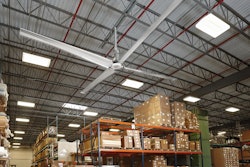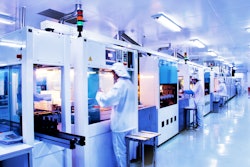Much of the distribution robotics technology that was in development as few as five years ago is now in operation and fulfilling its promise of reducing operating costs and boosting productivity. Driven by heightened competition among ecommerce retailers, many distribution centers (DCs) are looking to robots help meet growing consumer demand for rapid and personalized delivery.
Robots can make high-speed, intelligent selections with repeatability not achievable by humans. Equipped with advanced imaging and motion technology they can identify objects by shape, QR or other coding, move them adeptly from one place to another and maintain a history of all activity. Three distribution functions for which robots are especially well-suited are truck loading and unloading; AGV supported palletizing; and picking and placing.
Automating Truck Loading And Unloading
Most distributed goods arrive or leave the distribution center by truck, which in most warehouses are loaded or unloaded by hand. Human involvement has been essential because cartons and cases vary in size and weight and human judgment has been needed to pack and stack them effectively.
In a typical DC, a truck backs into a loading bay such that the bumpers of the loading bay contact the bumpers on the trailer, creating a gap is created between the loading bay and the truck. A dock leveler or dock plate bridges that gap to provide a fixed and substantially level surface. Loaders may then use moving equipment, such as forklifts or conveyor belts, to transport the cargo from the warehouse to the truck. But it has been humans who ultimately stack the cargo in the truck. Today’s robots, however, guided by 3D vision systems and barcode readers, can move goods directly from a conveyor belt onto a truck, eliminating the need for a human involvement, forklifts or other interceding elements.
Moreover, the robots can be programmed with weight sensors and sequencing software that optimizes the cargo for optimum utilization of space in the truck and unloading at the delivery site. And in unloading the automation process is reversed, where the robots can remove goods from the truck in a pattern optimized for unloading and placing them onto a conveyor or pallet for transport to a storage or work area.
Loading and unloading directly from a truck, can reducing loading costs by 16 to 20 percent and optimizing space usage can bring addition savings for both the DC and the end user. Savings are comparable for shipping containers as well as trucks.
AGV-Assisted Palletizing And Depalletizing
If the robot unloads onto a pallet, an automated guided vehicle (AGV) can then move that pallet to the desired location and unload it with maximum efficiency, integrating with other automation components, such as an automated storage and retrieval system (AS/RS) as needed. Robotic options for palletizing vary according to the structure of the goods the robot receives, whether they are stationery or moving and on the amount of human intervention is in the process. Following are the most common ways that robots assist in palletizing and depalletizing:
- Layer palletizing, in which a series of pushers or other mechanism prepares full layers of cartons ahead of the robotic palletizer.
- Stationery palletizing, in which the robot manages multiple input and output lanes from a fixed position.
- Linear palletizing, in which a standard palletizing robot sits on aservo-driven transfer, which follows a rail to service a series of case input and pallet output lanes.
- Collaborative palletizing, in which a palletizing robot shares the work with human operators.
- Mixed case palletizing, in which a robot builds pallets composed of different products and case sizes.
- Depalletizing, in which a robotic system moves cases from a pallet to an output conveyor, which in turn feeds an automatic storage and retrieval system, truck loader or other logistics system.
While the business benefits of robotic-assisted AGV-assisted palletizing will vary with the type of palletizing, combining these two technologies can improve productivity in pallet handling by between 150 and 200 percent.
Bin And Case Picking
Robots can also reduce pick and place time dramatically. The three most common robotic picking applications used to help meet these demands are structured bin-picking, non-structured bin-picking and case-picking.
In structured bin-picking, robots selected goods from a marked bin that orients the product to a specific location. The robot uses its attached vision system to locate the bin and pick the product to an outbound tote or carton. In non-structured bin-picking, the robot uses its vision or perception sensors to find the parts within in a bin and placement into an outbound carton. And in case-picking the robot uses perception technology to locate a case on a pallet and pick it to a conveyor or to another pallet for shipment.
Where a human might pick 10 to 15 parts per minute, a robot using structured picking might pick 30 to 60, with non-structured bin-picking 15 to 30 and case picking maybe 10 to 30 cases per minute. In either strategy, this represents a significant boots DC productivity.
Integrated Robotics
The cost savings and productivity benefits could be even more pronounced with robotic technologies are integrated with each other and with other DC automation functions. The fully automated DC, controlled by robots at every stage – from loading and unloading, palletizing and depalletizing, and picking and placing is now technically very doable. With increasing wage pressures and difficulty find qualified workers, the economics are rapidly more attractive. And the increasing utilization of warehouse execution systems (WES) technology makes it easier for centers to plan for and measure the business benefits of integrating robotic technologies that are integrated more tightly with other DC functions.
What’s Next?
While less than a quarter of all DCs are now utilizing robotic technology in any substantial ways, the adoption rate is steady and rising. Amazon alone increased their robot usage by 50 percent over the last year with over 45,000 robots working with their 230,000 human workers, Distribution centers remain on the frontlines in the battle for consumer’s hearts and the robotic technology that people will be using to fight those battles five years from now is in development today. This ranges from vacuum technology that makes it more efficient for robots to grip cases to machine learning that help robots make better decisions to AGVs with cameras and intelligence that allow them to automatically unload pallets from trailers. But there is no need to wait for the next generation of innovation. Vast opportunities of operational improvement remain untapped today.
Tim Criswell is Senior VP of Innovation and Technology Development at Daifuku Wynright.























